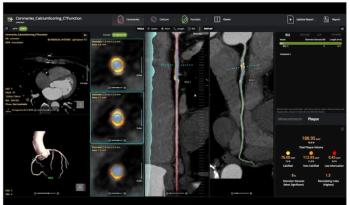
Isotope supply crash drives push for new moly sources
Knowledgeable Canadians considered the molybdenum-99 crisis of 2007 a national disgrace. A squabble between the Canadian Nuclear Safety Commission and Atomic Energy Canada, the federal corporation that owns and operates nuclear research facilities at Chalk River, ON, forced the National Research Universal reactor there to shut down. That action triggered a crisis that cut off production of molybdenum-99, the isotope that produces technetium-99m for thousands of health facilities across Canada and the U.S.
Knowledgeable Canadians considered the molybdenum-99 crisis of 2007 a national disgrace. A squabble between the Canadian Nuclear Safety Commission and Atomic Energy Canada, the federal corporation that owns and operates nuclear research facilities at Chalk River, ON, forced the National Research Universal reactor there to shut down. That action triggered a crisis that cut off production of molybdenum-99, the isotope that produces technetium-99m for thousands of health facilities across Canada and the U.S.
For Dr. Christopher O'Brien, past president of the Canadian Society of Nuclear Medicine, the crisis was very nearly a matter of life and death for two of his patients. Emergency nuclear medicine diagnostic services were cut off to two patients under O'Brien's care. Both were in renal failure. One had a suspected pulmonary embolism, and the other had suspected bleeding in the intestinal tract. Neither could be examined with CT because of known allergy to x-ray contrast media. The situation left physicians blind to whether the patients' conditions were actually life-threatening. Physicians held their breaths, and both patients survived.
O'Brien testified before the Canadian House Natural Resources Committee in February.
"Could these patients have died if they had not been appropriately taken care of? Absolutely," he said. "We found ourselves actually teetering on the brink of disaster just before the reactor was brought back online."
The shutdown started as routine maintenance Nov. 18, then escalated into a 28-day ordeal as Atomic Energy Canada officials installed backup motors for water pumps, a retrofit that nuclear safety officials insisted was needed to protect Canadians against the chance of reactor failure from a major earthquake or other calamity.
While energy and safety officials worked out their issues, isotope distributors were left in the dark about the length of the shutdown. This forced the Canadian healthcare system to the edge of disaster, O'Brien said.
Under normal conditions, the National Research Universal (NRU) reactor produces 70% of the Mo-99 relevant to 19 million nuclear medicine procedures performed in North America. It produces half the Mo-99 used in diagnostic medicine around the world.
MDS Nordion, a private $300 million Canadian company, refines and purifies the isotope at Chalk River, then ships it to radiopharmaceutical companies-mainly Lantheus Medical Imaging (formerly Bristol-Myers-Squibb Medical)-in North Billerica, MA. Mo-99 is put inside portable generators that are then distributed to healthcare providers.
Tc-99m is a natural byproduct of Mo-99 decay, which is harvested daily by running saline solution through a generator.
Speed is of the essence for Mo-99 distribution because of its six-day half-life. Supplies become strained after only a four-day reactor shutdown. Longer disruptions at the NRU plant engender the need for help from alternative resources in Belgium, the Netherlands, or South Africa. The NRU plant has enough excess capacity to address the emergency needs of Mo-99 producers elsewhere, but careful preparation is needed to draw from this capacity to meet Nordion's prodigious needs. Excess capacity among all of Nordion's alternative sources is not sufficient to meet its needs during an extended shutdown, said Grant Malkoske, Nordion's vice president of strategic technologies and global logistics.
Uncertainties about the probable length of the Chalk River shutdown made production fulfillment impossible (see timeline). Six days passed before European and South African sources were advised the NRU plant would be down until at least early December.
Most European providers were slow to respond despite daily phone calls from Malkoske. The BR-2 reactor in Mol, Belgium, was already shut down for routine maintenance. The High Flux Reactor at Petten in the Netherlands supplies one quarter of the North American demand for Mo-99 and is distributed by Covidien in Hazelwood, MO, but it did not ship isotopes to Canada until Dec. 14.
In the meantime, the Nuclear Energy Corporation of South Africa was Nordion's sole source, and it covered only 20% of the demand. As a result, hospitals in the U.S. and Canada rationed their technetium isotope supplies or shut down nuclear medicine operations as their Tc-99m generators were exhausted.
Canadian Health Minister Tony Clement was not informed about the shortage until at least Dec. 4, several days after Nordion had issued a news release alerting stockholders that the shutdown would have a $4 million impact on sales. With the Canadian nuclear safety officials insisting on a second backup motor, Atomic Energy Canada announced Dec. 4 that the shutdown could extend into February.
The crisis reached the Canadian House of Commons Dec. 12. In an unprecedented move, the Nuclear Safety Commission's Linda Keen and Atomic Energy Canada chairman Michael Burns were called to the floor to explain the situation to an angry Prime Minister Stephen Harper and the assembled members of Parliament.
"Testimony from last night said that the current reactor is able to withstand everything except one event in the next 50,000 years versus the need for cancer patients and cardiac patients for isotopes," Clement said afterwards. "I think the choice is clear."
Atomic Energy Canada was ordered to restart the NRU reactor, and Nordion returned to full capacity by Dec. 20. Burns resigned, and Keen was fired but remains a full-time member of the safety commission.
The immediate crisis was over, but the political discussion that followed revealed that much more is wrong with the North American isotope supply system than the clash of two bureaucrats.
Atomic Energy Canada's failure to start two reactors designed to replace the aging NRU facility is one problem. The Multipurpose Applied Physics Lattice Experiment (MAPLE) reactors have sat idle since their 2000 completion despite an estimated $465 million spent so far by the Canadian government to overcome design problems that have kept them offline.
"Government negligence, pure and simple, landed us in this mess," said Liberal MP Michael Ignatieff during House deliberations. "We have a 50-year-old facility at Chalk River, no functioning backup reactor, and no guarantee that we won't run out of medical isotopes again. When will the government get our nuclear house in order?"
TERRORISM COMPLICATION
A confounding issue is the perceived terrorist threat to the U.S. Department of Energy's export of weapons-grade uranium-235, which is used as targets for Mo-99 production. The isotope is produced when enriched uranium is bombarded by neutrons in a reactor core.
Atomic Energy Canada and Nordion would have been subject to U.S. restrictions against the export of weapons-grade uranium were it not for an exemption passed by Congress in 2005. The Burr-Bond amendment, sponsored by Rep. Richard Burr (D-NC) and Sen. Christopher Bond (R-MO), permitted continued shipments of weapons-grade uranium to the Chalk River facility as well as to medical isotope generators in Belgium, France, Germany, and the Netherlands.
Nordion's alleged role in agitating for the bill is explored in a report written by Nordion critic Alan J. Kuperman. It was presented at the Reduced Enrichment for Research and Test Reactors (RERTR) conference in Boston in 2005. The text was posted on the Internet (
Because of the exemption, a specially equipped chartered airplane containing vials of highly enriched U-235 and protected by heavily armed guards flies from an undisclosed DOE laboratory in the U.S. to Chalk River several times a year. Each secure flight costs tens of thousands of dollars, said Dr. Richard Reba, a professor of nuclear medicine at Georgetown University. The facility reportedly consumes 12 kg of highly enriched uranium annually for molybdenum production.
The 2007 isotope shortage underscores the country's vulnerability from reliance on foreign sources for Mo-99. Many nuclear physicians in the U.S. were frustrated by the lack of options when the NRU reactor went down, according to Society of Nuclear Medicine president Dr. Alexander McEwan, director of oncologic imaging at Cross Cancer Center in Edmonton, AB.
"There is no doubt in my mind that the Americans never again want to be at the beck and call of a Canadian regulator or a failing Canadian company," he said in an interview.
The U.S. has been without a domestic source since 1989. Some nuclear medicine practitioners and the SNM have called for the federal government and private industry to fill the gap. The DOE did establish a modest backup facility at Sandia National Laboratories in New Mexico in 1997, but it was phased out by 1999.
Other potential initiatives have been deterred by the promise of new reactor development by Atomic Energy Canada, according to incoming SNM president Robert Achter, Ph.D. The reactors could produce twice the amount of Mo-99 needed for the 19 million technetium-based procedures performed annually in the U.S. and Canada. Central to the problems at two yet-to-open reactors are an inability to operate at a negative power coefficient reactivity value. Tests have repeatedly produced positive values, suggesting problems in the case of accident. Results from a new set of tests this spring had not been announced as of May 1.
Most sources say there is little chance that Atomic Energy Canada will open even one of the plants by October as planned. Some believe the defects can never be repaired. Officials from the company and the Canadian Nuclear Safety Commission would not comment because of a news blackout linked to an ongoing independent investigation of the isotope crisis.
CONVERTING TO OTHER SOURCES
Congress has assigned the question of highly enriched uranium export to a National Academies of Science panel. The Committee on Medical Isotope Production without Highly Enriched Uranium is investigating the feasibility of procuring medical isotope supplies from commercial sources that do not use high-energy uranium. Its report, to be published this fall, will also examine the cost differential between reactors and medical production systems that use high-enriched and low-enriched targets, according to Reba, a member of the committee.
The Bush administration has pushed for the conversion to low-enriched uranium through the Global Threat Reduction Initiative within the DOE's National Nuclear Security Administration. An initiative program aims at eliminating civilian applications of highly enriched uranium. As outlined in the NNSA 2007 strategic plan, 48 nuclear reactors around the world had been converted from high-enriched to low-enriched fuel as of December 2006. Another 81 conversions were planned, and 78 reactors were exempted either because they are defense-related or because of design considerations.
Initiative officials hope low-enriched uranium can be a viable target for Mo-99 production as well. Its 2007 strategic plan singles out small-scale Mo-99 production operations in Argentina and Australia that use low-enriched uranium targets.
The officials concede that a report about low-enriched uranium-based production at the Open Pool Australian Lightwater reactor may have been somewhat premature, however. Sources who have visited the plant say production had not begun before the new 20-MW research reactor was shut down in 2007 because of defects in its low-enriched fuel.
Nordion's Malkoske is skeptical about converting to low-grade targets without supply problems. The five largest producers of Mo-99 all still use high-enriched targets. These are inherently more efficient in isotope production and produce less waste than lower grade uranium.
"From our point of view, it is a government issue that needs the governments to step in to resolve," he said.
DOMESTIC SOURCES
At least three initiatives look toward reestablishing molybdenum production in the U.S.
Ralph Butler, director of the University of Missouri Research Reactor (MURR), plans to spend $40 million in the next six years to upgrade his operations to meet up to half of the nation's need for Mo-99. Because of the Missouri reactor team's focus on research service and education, Butler figures it has the necessary experience and know-how for the enterprise.
Located near the Columbia campus of the University of Missouri, the 10-MW reactor is the most powerful university-based reactor in the U.S. It operates at full power around the clock, producing 41 isotopes for commercial sale. The facility supports a staff of 150 and produces enough revenue to cover 80% of its operating budget. Butler sees Mo-99 production at the Missouri reactor as a business opportunity because of 10% annual market growth. He also considers it his patriotic duty.
"Someday there may be a security event that causes us to close borders to the shipment of radioisotopes," he said. "About 35,000 patients a week receive a nuclear procedure, and 80% of those procedures use technetium. What are we to do for those patients? So I just think it is important that the U.S. have a domestic source."
Reactor modifications will involve the conversion of two radiation positions near the core to accept low-enriched uranium targets. Material handling and processing facilities-including heavily shielded hot cells, where technicians manipulate nuclear material from behind clear glass barriers, and a sophisticated ventilation system-must be built. Their design and construction are subject to Nuclear Regulatory Commission inspections and approval.
Missouri reactor physicists are working with George Vandegriff, Ph.D., of the Argonne National Laboratory to develop low-enriched target vessels and a modified Cintichem process for Mo-99 production. These new techniques will also be shared with the International Atomic Energy Agency to guide other countries in the development of research reactor capabilities to address their own Mo-99 needs, according to Butler.
A $500,000 grant from the DOE and NNSA as part of the Global Threat Reduction Initiative is funding early planning. Combined federal, venture capital, and philanthropic funding will probably pay for construction. Without major construction or regulatory delays, the project should be ready for full-scale production by 2012, he said.
NEW SOLUTION FROM OLD TECHNOLOGY
Babcock & Wilcox Technical Services Group has given a new twist to an old reactor design that could lead to a compact and inexpensive way to produce the Mo-99 isotope. Based in Lynchburg, VA, B&W has a long history of constructing nuclear power plants for the electric utility industry and supplying compact reactors for Navy submarines.
The company has assembled a design team, directed by senior program manager W. Evan Reynolds, to implement a patented technology that uses an aqueous homogeneous reactor with low-enriched uranium to produce the isotope. Rather than using the hard fuel or hard targets of conventional processes, the B&W approach involves dissolving uranium salt in acid and water, Reynolds said. With the proper configuration, uranium fission occurs and naturally produces molybdenum. The reactor is then shut down, and the liquid undergoes a separation process to extract the isotope. A purification process similar to the standard techniques used at Chalk River produces a usable product.
An aqueous homogeneous reactor generates only 200 KW. It involves a container about the size of a 55-gallon drum to produce about 1100 six-day curies of Mo-99 per week, or about 20% of domestic consumption, according to Reynolds. A network of reactors could cover a higher proportion.
About 30 aqueous homogeneous reactors have been built since the 1950s, though few remain in operation. Reynolds estimates that reactors and a processing system addressing half of the U.S. demand could be built for less than $100 million.
The group is looking for private investors for construction funds. Reynolds and his colleagues are working with the Argonne National Laboratory on the separation and purification process. Any facility would require NRC licensing and would be subject to FDA good manufacturing practice codes. A working complex could be in place as soon as 2014, he said.
General Atomics in San Diego is working on an Mo-99 generator using its popular Training, Research, and Isotopes General Atomics TRIGA Mark-F reactor as an off-the-shelf solution. The firm proposes building turnkey facilities, including a 10-MW TRIGA reactor and processing facilities, for about $120 million, according to Achter.
Sixty-six TRIGA reactors have been installed at universities, industrial labs, and government facilities since 1999. Installations include a 10-MW reactor at the Ongkhark Nuclear Research Center in Thailand. When completed, the project was to provide medical isotopes for cancer therapy and diagnosis.
SEEKING COOPERATION
Better cooperation among the current Mo-99 producers is the only way to assure an uninterrupted isotope supply during the six or more years needed to secure a domestic source, Achter said. He called for more reciprocal agreements, such as Atomic Energy Canada's pact with the operators of the High Flux Reactor at Petten.
"We need to make sure that every possible source for Mo-99 can be utilized in the next unanticipated outage or interruption," he said.
The Europeans appear to want improved communications as well. The Association of Imaging Producers and Equipment Suppliers, based in Brussels, Belgium, issued a press release on Dec. 14 calling for more consultations among stakeholders to ensure sufficient supplies.
A cooperation pact exists between the Nuclear Research and Consultancy Group, which operates the Petten facility, and the Institut National des Radioéléments in Fleurus, Belgium, according to a Feb. 26, 2008, report in the Canadian Medical Association Journal. The two organizations coordinate production schedules to assure that one reactor is always operating. Maintenance plans are coordinated through regular communications with other global suppliers. They also exchange information with NTP in South Africa.
But Nordion is not in that loop. The journal reported that Kevin Charlton, commercial manager for business development and sales with the Nuclear Research and Consultancy Group, complained that his group never gets information from the Canadians. In response, Nordion's Malkoske said in an interview with Diagnostic Imaging that his group is attempting to understand the nature of the Europeans' concerns, though better communication and planning are only partial answers.
"Having the maintenance schedules for the various reactors around the world might help routine situations, but if you are into an extended outage beyond seven days, then communication and planning will not alleviate that," Malkoske said. "The precipitous events are the problematic ones."
Mr. Brice is senior editor of Diagnostic Imaging.
Newsletter
Stay at the forefront of radiology with the Diagnostic Imaging newsletter, delivering the latest news, clinical insights, and imaging advancements for today’s radiologists.






























